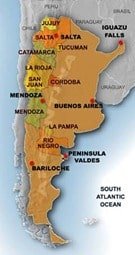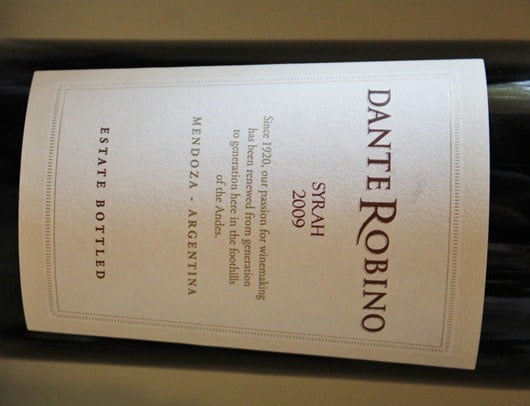Grape
100% Syrah
Facts
In France, Syrah dominates the Rhone region where it’s often blended with small amounts of Viognier (a white grape) in order to add “aromatic complexity”, and mellow the wines out a little.
Dante Robino was born in Canelli in the Piedmont region of North-West Italy in 1885. After learning the art of turning grapes into wine, he emigrated to Argentina, starting his own winery in 1920.
For me, well-made Syrah can often be very “closed” upon release; needing either another year-or-three in the bottle, either that or a little decanting / aerating to really show their true potential. The Dante Robino Syrah is a perfect example of what can be achieved with just a little air! (See tasting notes below)
Syrah / Shiraz is a dark black grape with a very thick skin, and it’s because of this thick skin that the wines are usually highly concentrated and jam-packed full of intense flavors.
Syrah and Shiraz are used interchangeably around the world to refer to the same grape, but the grape also goes by a few other synonyms such as Balsamina, Candive, Hignin Noir, Marsanne Noir, Sirac, Syra, and Sereine, although I can’t say I’ve ever seen a bottle labeled with any of these crazy terms!
For more information, check out the Dante Robino website and Facebook Page.
 Place (click map for larger view)
Place (click map for larger view)
Argentina is the world’s 5th largest producer of wine. 80% of Argentina’s wine comes from Mendoza, South America’s largest wine producing region.
Malbec has been receiving all the credit in Argentina for the past couple of years, but try not to get stuck in a “blue fruit rut”, and open your mind to exploring other red grapes. Syrah, Cabernet, and even the more obscure Bonarda are all yielding some excellent, but often overlooked wines, that can easily give most Californian bottling’s a run for their money.
Mendoza is divided into 4 growing areas: Lujan du Cuyo, Maipu, Uco Valley, and Eastern Mendoza.
The Dante Robino vineyards are situated more than 2,500 feet above sea level in the Andes Foothills. Grapes in the Mendoza region have one of the longest "hang-times" in the world, due to lengthy growing season, marked by warm and sunny days and cool nights.
This kind of season is thought to create more balanced wines, with ripe fruit flavors and smooth tannins. The nerdy term for these flavor compounds is "polyphenols". Argentine wines have some of the highest polyphenol counts of any place in the world.
The growing areas of Mendoza receive less than 10 inches of rain per year, and so most vineyards rely on irrigation water from year-round snow melt from the Andes mountains.
Taste
A deep-dark concentrated crimson, showing straight-off that this isn’t going to be a wimpy Syrah. Very closed upon first being opened, this wine needs plenty of time to breath! In fact; I opened this bottle poured a glass, stuck the cork back in, and forgot about it until the next day. After 24 hours it had totally evolved, with the blackberry and cassis really coming through. The Dante Robino Syrah also showing dried herbs, eucalyptus, a little damp earth and tree bark. I also almost get kind of a smoked meat quality. The black fruit turns into red fruit towards the medium finish. I can suggest another year or two in the bottle, where the wine will certainly improve.
Food Pairing
Red meat shouldn’t be too much of a surprise! Flank steak, ribeye, beef stew, and rosemary seasoned lamb would all work excellently. Also give thought to thick and chunky red-sauce pastas, olive tapenade, teriyaki, and even bitter chocolate; but not on the same plate of course…
Price
$14.99 average retail, and a definite bargain for an Estate Bottled wine!





